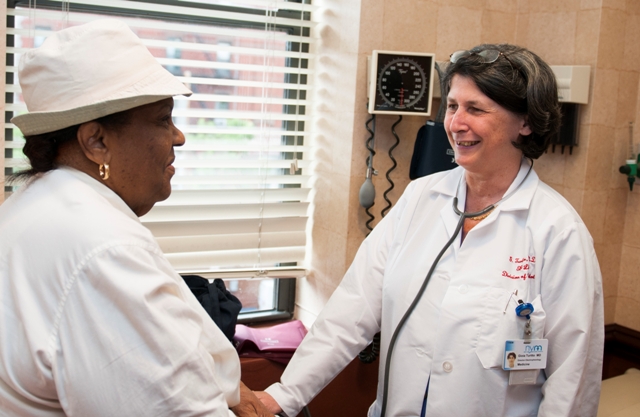NYM Uses Lasers to Maintain Cardiac Devices
Using Lasers to Maintain Cardiac Devices at New York Methodist Hospital
Feb 14, 2013
Brooklyn, NY

Gioia Turitto, MD, director of electrophysiology services at New York Methodist Hospital, with a patient. Dr. Turitto is part of NYM's team of cardiologists dedicated to laser lead extraction procedures.
New York Methodist Hospital (NYM) has recently adopted an advanced technique for the maintenance of implanted heart devices called laser lead extraction (LLE). Over 500,000 Americans currently live with an implanted cardiac device, such as a pacemaker or an implanted cardiac defibrillator (ICD). Since their invention, these devices have evolved considerably—pacemakers used to be the size of hamburgers, and now they're the size of silver dollars. Thanks to LLE, which is performed by a team of cardiologists at NYM, the way that these devices are maintained has evolved as well.
Implanted cardiac devices have always had the same crucial purpose: stabilizing the heartbeats of patients with potentially life-threatening arrhythmias (irregular heartbeats). A pacemaker or ICD functions by sending electrical impulses from the device itself through leads (wires) that are attached to the heart muscles. As with all electronic equipment, these devices require periodic maintenance over the years, either because of infection, hardware problems, or the simple need for an upgrade or a new battery. Occasionally, this requires removing the wires from the body—a potentially high-risk procedure.
"When a heart device is implanted, the body immediately starts to form scar tissue around both the device itself and around the wires that connect it to the heart," said Gioia Turrito, MD, director of electrophysiology services at NYM. "The more time passes, the more scar tissue forms, the more 'attached' these systems become to the body. The device itself is usually situated in the chest just below the skin, so accessing it for maintenance is a relatively simple procedure. However, the wires can be over two feet in length, run a long course from the device through the veins into the heart, and are attached directly to the heart walls and blood vessels. Previously, gentle pulling and mechanical techniques—which sometimes carried considerable risk of complication—were the only non-invasive ways to remove those wires. Laser lead extraction is making those methods obsolete."
LLE procedures at NYM are performed by electrophysiologists Brian Wong, MD and Bharath Reddy, M.D. During a laser lead extraction, Dr. Wong and Dr. Reddy make a small incision over the heart device. They then thread a small device called a laser sheath along the path of the leads to the heart. The laser sheath is only a few millimeters in diameter, and as it is threaded, it emits a concentrated beam of ultraviolet light that vaporizes the scar tissue that has formed, separating the leads from the body. Once the leads have been detached, Dr. Reddy and Dr. Wong remove the wires through the original incision. Complications from LLE procedures occur in less than two percent of cases, but in the rare event that surgical intervention is necessary, cardiothoracic surgeon Iosif Gulkarov, MD is on hand for every laser lead extraction procedure.
"Laser lead extraction is already making the maintenance of pacemakers and ICDs more effective," said Dr. Reddy, "and NYM is the only center in Brooklyn with a team of cardiologists dedicated to LLE. It's truly a leap forward in our ability to safely maintain all aspects of implanted heart devices."
Media Contact:
Media Relations 718-780-5367



